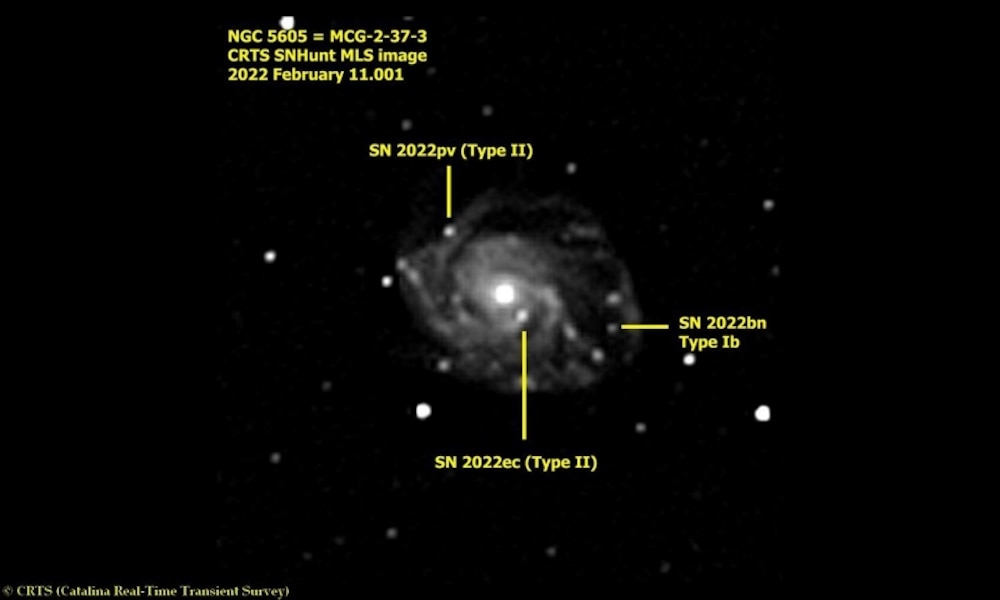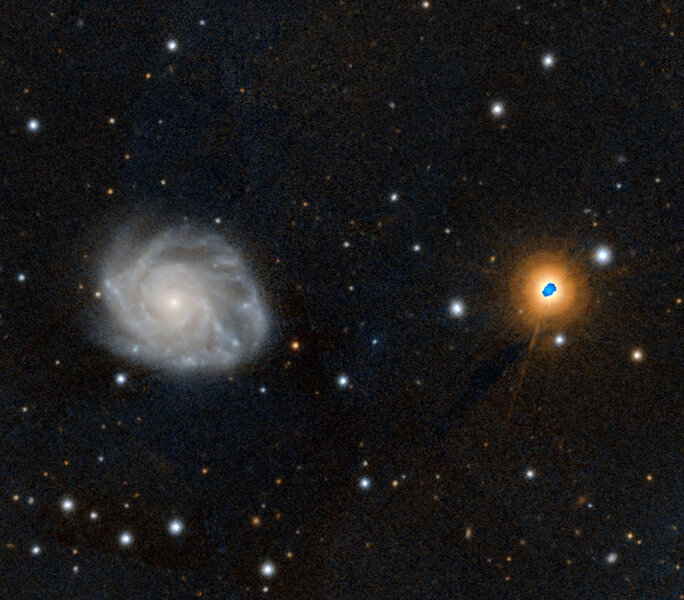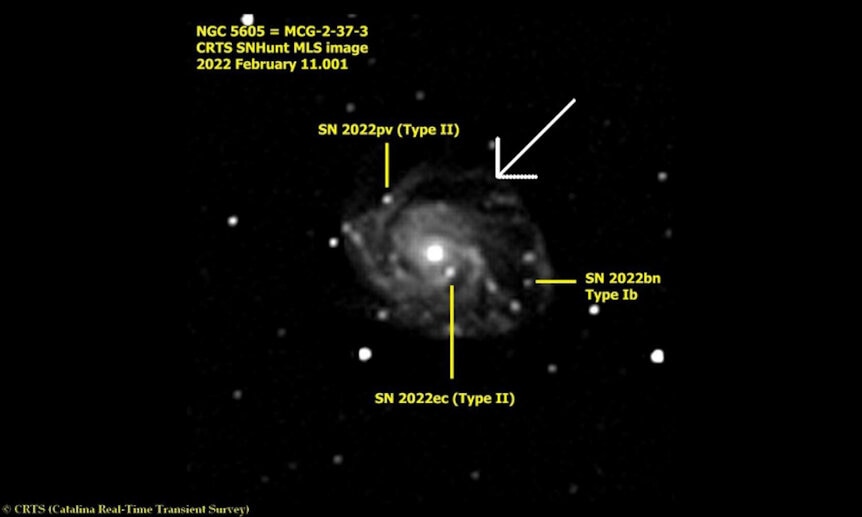Create a free profile to get unlimited access to exclusive videos, sweepstakes, and more!
For the first time, three supernovae are seen at the same time in a single galaxy!
The spiral galaxy NGC 5605 is popping off exploding stars.

In an unprecedented event, there are THREE active supernovae simultaneously seen exploding in a galaxy right now!
While two supernovae seen at the same time in the same galaxy has happened before, to my knowledge there has never been three. That’s pretty cool!
The galaxy is NGC 5605, a lovely spiral about 160 million light-years away, and a little more than half the size of the Milky Way. After searching the journals it looks to me to be a pretty but rather unremarkable galaxy, with the only real distinguishing feature of being what we call an active galaxy, one with a supermassive black hole in its center that’s actively feeding on material which then glows very brightly. That’s pretty common, and almost certainly unrelated to the three supernovae.
The three exploding stars are called SN2022bn, SN2022ec, and SN2022pv — supernovae are designated by the letters SN for “supernova”, the year they were discovered in, and then a combination of letters depicting the order they’re seen in that year. The first is A, the second B, and so on up to Z, then it starts again with aa, ab, etc. That makes SN2022bn the 66th supernova seen this year, and if you want to figure out the number for ec and pv feel free to do so.
All three supernovae are what we call core collapse supernovae. A massive star runs through its nuclear fuel rather rapidly, in just a few million to maybe a few dozen million years, fusing hydrogen into helium, then helium into carbon and oxygen, and so on, creating ever-heavier elements that build up in its core. When it gets to iron it has a problem: Fusing iron takes more energy than it generates. The core needs to be making energy to support itself against the immense gravity trying to shrink it down. That lack of energy — plus iron fusion robs the core of electrons that it also needs to support itself — causes it to collapse. It falls in on itself, creating either a neutron star or black hole. A ridiculously huge blast of energy is released, so much that the outer layers of the star are completely blown away. Boom. Supernova.
We call that a Type II supernova. Sometimes the massive star blows off its outer layers slowly before it explodes. When that happens we don’t see any hydrogen in its spectrum, and by definition those are Type I supernovae. Depending on details of the spectra, it can then be subclassified into type Ib or Ic. SN2022ec and pv were both Type II, but bn was a Type Ib. The same sort of explosion, but somewhat different circumstances.
On average, a galaxy will have a supernova in it something like one to four times per century, and they typically brighten and fade over the course of a few months, so seeing three in one galaxy is pretty unusual… but big surveys scanning the skies routinely look at millions of galaxies, so statistically speaking this event was inevitable. Tens of thousands of supernovae are now seen every year. This is the first time this has been seen, but it’ll happen more often in the future.
But it brings up a fun thing to think about.
A spiral galaxy is a flat disk, in the case of NGC 5605 something like 70,000 light-years across and maybe a couple of thousand thick. We see this galaxy very nearly face-on, so it’s possible these supernovae were actually separated in time by a thousand or more years, but lined up just right so that we see them at the same time.
Think of it this way: Say SN2022bn was on the far side of the disk from us, and SN2022pv on the near side. If the massive star that blew up to create bn happened first, its light traveled two thousand or so light-years through the disk and reached the star that blew up to create pv just as that star blew up as well, then the light from both traveled to us neck and neck, even though one event happened earlier. In that sense we see them at the same time even though they happened quite a bit of time apart.
What’s really funny here is what you’d see if you were in that galaxy. SN2022bn and pv are on opposite sides of the galaxy, roughly 60,000 light years apart. If you were on a planet orbiting some star near SN2022bn and saw it explode, you wouldn’t see the light from SN2022pv for another 60,000 years. Even though we, in a galaxy far, far away, saw them at the same time.
Galaxies are immense structures, and in this case the speed of light is slow compared to that distance. Geometry counts a lot here. In fact, there is a spot in NGC 5605 where, if you were there, you’d also see all three of the stars explode at the same time. It has to be equidistant from all three of the stars, and playing with the image a bit — and assuming the galaxy is flat — I figure it’s right about the spot I’ve arrowed in the image here:
Imagine! We haven’t seen a supernova in the Milky Way galaxy in over 400 years — the telescope was invented after the light from that one reached us! — but in the right spot in NGC 5605 you’d see three at the time. Well, 157 million years ago you’d have seen them, but still.
And that makes me wonder. The Milky Way is 120,000 light-years across, and we’re about 26,000 light-years from the center. If even one star explodes every century in our home galaxy, the light from thousands of supernovae is speeding towards us right now. We just won’t see most of them for a long, long time. Tens of thousands of years.
So soak up the view from NGC 5605. We may never see such a sight in the Milky Way.
Tip o’ the dew shield to BA reader Mantiss69 for letting me know about this story! And to astronomers George Djorgovski and Andrew Drake for their help with the Catalina Sky Real-time Transient Survey image of NGC 5605.
CORRECTION (April 14, 2022): The images of the three supernovae in NGC 5605 were originally miscredited to just CRTS and did not include the astronomers who took it and noted the supernovae in it. The caption has been updated. Also, the original image can be found on Flickr. My thanks to Stan Howerton for pointing this out!





























